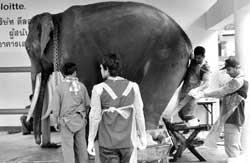
Asian jumbo project gets underwayA project called "Managing the Health and Reproduction of Elephant Populations in Asia" was recently initiated by the Faculty of Veterinary Medicine and Animal Science of the University of Peradeniya, together with partners in Universities of Thailand (Kasetsart and Chiang Mai), the Netherlands (Utrecht) and the UK (Royal Veterinary College) with funding from the European Union "EU-Asia Link Project".
Preservation of the domesticated and wild elephant will be the focus of the three-year programme, to bring clear and lasting benefits to the participating countries. Research will be focused on methods for increasing the breeding of domesticated elephants through natural as well as artificial breeding technologies. The project will also study methods for the control of "musth", aggression and breeding in wild elephant males through immunization procedures, which will have applications for reducing the Human-Elephant Conflict (HEC) in selected areas. Six specialists in the reproduction and management of elephants in Sri Lanka - Dr. (Mrs) Niromi Jayasekera, Prof. B.M.A. Oswin Perera, Dr. Anil Pushpakumara and Dr. Aruna Amerasinghe from the University of Peradeniya, Dr. R.C. Rajapakse from the Pinnawela Elephant Orphanage and Dr. Lasantha Perera from the Dehiwala Zoological Gardens attended the inaugural symposium and workshop held in Bangkok recently: The project's objective is also human resource development in the Asian Institutes. This will be achieved by academic training of staff and students, strengthening the links between the institutions, and dissemination of knowledge acquired by the Asian participants within their own and neighbouring countries. Prof. Oswin Perera presented a paper on "The status of elephants in Sri Lanka and the Human-Elephant Conflict" at the symposium, in which he highlighted several aspects. He revealed that estimates of the wild elephant population in the island published by various authors over the past two decades range from 1,500 to 6,000. At present the Department of Wildlife Conservation considers the population to be between 3,500 and 4,000. Thus Sri Lanka, which has a land area of 65,000 km2, appears to carry the highest number of elephants per unit land area compared to other Asian countries inhabited by wild elephants. In addition to the above numbers that inhabit Protected Areas, more than 1,500 elephants are found predominantly outside such areas, in clumps of forests that are now fragmented by human habitation and cultivation, he said. The number of captive elephants in the country was around 650 in the 1970s, but has now declined to around 160. During the last decade alone, 1,369 wild elephants were killed, with gunshot injuries accounting for 56% of them.The number of people killed by wild elephants in Sri Lanka between 1992 and 2001 was 536. The above findings show the need for scientists and those involved in elephant conservation to get together and undertake studies on the appropriate methods that can be applied to mitigate the HEC in areas where it has become acute. Such methods should involve the affected communities and ensure that the wild elephant comes to be regarded as a valuable resource rather than a pest, Prof. Perera concluded. |
|| Front
Page | News | Editorial | Columns | Sports | Plus | Financial
Times | International | Mirror | TV
Times | Funday
Times || |
| |
Reproduction of articles permitted when used without any alterations to contents and the source. |
© Copyright
2007 | Wijeya
Newspapers Ltd.Colombo. Sri Lanka. All Rights Reserved. |
